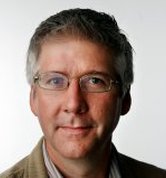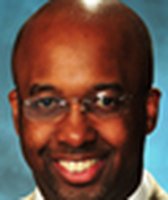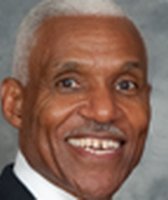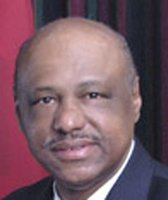Stand up for the facts!
Our only agenda is to publish the truth so you can be an informed participant in democracy.
We need your help.
I would like to contribute

Tennessee state Sen. Stacey Campfield sparked an uproar with his comments about the origin of AIDS.
Since Stacey Campfield’s controversial comments about gay people and HIV last week went viral, the Republican state senator from Knoxville has given another interview with a gay-rights proponent, put up at least two blog posts and even been asked to leave a Knoxville restaurant.
To check Campfield's claims, PolitiFact Tennessee interviewed experts on HIV/AIDS research and researchers who have evaluated thousands of studies on the history and genetic origins of the disease (see sources, to the right). We put one of the claims on the Truth-O-Meter and will explore others in this article.
The context
Campfield’s claims in an interview with Michelangelo Signorile, a gay man and gay-rights advocate with a satellite radio show called OutQ, have provoked controversy throughout the state and beyond. The claims are associated with the bill Campfield is championing that declares only sexuality involving "natural human reproduction" can be discussed in the state’s K-8 public-school classrooms. It has passed the Tennessee Senate.
Campfield calls it the "Don’t Teach Gay" bill, saying he believes homosexuality is more dangerous than heterosexuality is and that "there are people who want to glorify risky behavior in schools." Detractors call it the "Don’t Say Gay" bill and warn that its passage would lead to state sanction of anti-gay bullying and harassment and prevent teachers and administrators from effectively reaching out to students who may need help dealing with sexuality issues.
The interview with Signorile stuck to arguments about the bill until they began arguing over whether homosexuality is "harmful." Campfield asserted that "in some ways" he believes it is. That’s when he brought up AIDS, a condition caused by the human immunodeficiency virus, better known as HIV.
HIV is one of many sexually transmitted diseases that can cause potentially life-threatening conditions, and it also can be contracted in other ways -- direct blood contact with the virus being the most efficient means of transmission. Campfield does not mention other sexually transmitted diseases and how they are contracted, nor does he seem concerned with whether female homosexual acts pose a greater physical risk than heterosexual acts.
So we will stick to discussion of HIV and what scientists and doctors refer to as men having sex with men (MSM).
We found Huffington Post's account of the interview has an imperfect transcript, at times deceptively running together Campfield’s statements and missing key words. So we are relying on our own verbatim transcript from the link Signorelle provides. About 12 minutes in, the interview veers away from public policy:
CAMPFIELD: Most people realize that AIDS came from the homosexual community.
SIGNORILE: No, it did not. Do you know the history of AIDS?
CAMPFIELD: It was one guy screwing a monkey, if I recall correctly, and then having sex with men.
SIGNORILE: No, it was not one guy screwing a monkey. It was somebody in Africa. Do you know the history of AIDS? Because I can tell you in a minute? It was somebody in Africa who actually killed a monkey, because they eat the meat of many animals, as I’m sure you do, I’m sure you eat the meat of animals. And they ate the meat of a monkey and the blood, they chopped it up, and it got in a cut and that’s how AIDS then spread among heterosexuals all through Africa, and it is a pandemic around the world.
CAMPFIELD: It was an airline pilot, I believe, if I recall correctly.
From that exchange, there has been much fallout, and it is important to remember Campfield makes his assertions in part to justify the public policies he wants instituted.
So let’s go through the claims.
Claim No. 1: "AIDS came from the homosexual community."
The quick answer is, "No." Dr. Jacques Pepin is an infectious disease specialist and epidemiologist at the University of Sherbrooke in Canada and author of the recently-published book "The Origin of AIDS." The book relies on thousands of peer-reviewed studies, some of which used DNA samples to meticulously trace the illness back to the 1920s (in humans) and earlier (in monkeys and apes).
Signorile, who featured Pepin on his radio show late last year, was essentially paraphrasing Pepin’s findings with accuracy, except that he confused "monkey" with "ape" -- remember this distinction because it is an important part of this tale.
We spoke with Pepin, who says he has conducted research in 16 African countries, and got a more precise account. HIV originated in Central Africa, likely sometime in 1921, from a hunter who was exposed to contaminated blood from an ape he had killed for food, he said.
A slow dissemination through Africa followed, Pepin said, through heterosexual transmission, needle injections and blood transfusions. It stayed at a "low level," he says, until 1966 or 1967 when it "was exported to Haiti" and "from there to the United States, probably at the beginning of the 1970s."
Here is where Campfield can claim some degree of accuracy -- Pepin acknowledges that the spread of the disease in North America can be attributed to promiscuous unprotected sex among homosexuals. "It is true that at this point in time the spread in the United States was mostly through homosexual sex but that was 60 or 70 years after the virus began spreading in Africa," Pepin said.
Other sources and experts backed up Pepin’s analysis. See sources for direct links.
Claim No. 2: AIDS was brought into the human population because a man in Africa had sex "with a monkey" then had "sex with men."
No way, say Pepin and Dr. Beatrice Hahn, a former UAB geneticist now at the University of Pennsylvania, who co-authored a 2010 research paper titled, "Origin of HIV and AIDS Pandemic." She has concluded that the form of HIV most prevalent around the world, known as HIV-1 Group M, originated in chimpanzees -- and chimps are considered apes, not monkeys.
Her paper, which cites studies from 150 research papers and was written with Penn colleague Paul Sharp, formerly of University of Edinburgh, features a figure showing 10 different "simians," which is how monkeys and apes are classified. The pictures in the figure show how SIV -- "simian immunodeficiency virus" -- moved from simians to humans in two major forms, HIV-1 and HIV-2.
SIV does not cause serious illness in some simians the way HIV does in humans.
Hahn said HIV-1, the most common AIDS virus, has been documented to have emerged following "four independent transmissions of ape viruses -- not monkey viruses."
A second human AIDS virus that is largely restricted to West Africa is called HIV-2, and it is declining and being replaced by HIV-1, according to the paper. That less prevalent form has been traced to a monkey called the Sooty mangabey.
Hahn says the most likely way that the simian precursors of HIV-1 and HIV-2 entered the human population was from bushmeat hunters who killed simians for their meat. Pepin and other researchers have written the same thing, and we found no serious academic papers mentioning simian-human sex as a possible transmission route.
In one of his blog posts, Campfield wrote: "The research on sex with a monkey being the first transmitter of AIDS has not been proven nor firmly dis proven (sic). It is one of about 5 theories I was able to find on the source of AIDS."
Hahn begs to differ: "It surely wasn’t transmitted through sexual activity." Among other things, apes could easily slaughter a human trying anything.
We’ve put this claim on the Truth-O-Meter, and it landed on Pants On Fire.
Claim No. 3: One specific person is responsible for the spread of HIV through North America
As Campfield later acknowledged on his blog, the "airline pilot" was actually a Canadian flight attendant named Gaetan Dugas. He was a primary subject in the 1987 book, "And The Band Played On", which documented the early impact of AIDS. It is not disputed that Dugas spread the disease through homosexual sex acts with other men, but a reference to him as "Patient Zero" is often misinterpreted, according to Dr. Rafael Mazin, the Pan-American Health Organization’s senior advisor on HIV, sexually transmitted infections and hepatitis.
Mazin wrote to us in an email: "Mr. Dugas is known as ‘patient zero’ not because he was ‘responsible’ for the dissemination of the epidemic but because it was easy and practical to track his sexual contacts. Thus, in a scheme of his sexual network he appeared at the center or ‘zero.’ Unfortunately, ignorance about epidemiological methodologies has ascribed to him the very infamous reputation of spreading the virus in a whole region of the continent."
Pepin and others say the spread of HIV involved many people and the notion that Dugas was primary distributor of HIV through North America has been widely discredited. Pepin calls it "in retrospect a bit ridiculous" to claim one person was responsible for triggering the AIDS epidemic in America.
Claim No. 4: It’s "virtually impossible to contract AIDS … through heterosexual sex."
Wrong. Many thousands of men and women have contracted it through heterosexual sex in the United States and around the world. After Signorile challenged Campfield on his claim about Dugas, they argued over the risks of contraction, male-female heterosexual activity vs. male-male homosexual activity.
Campfield: "My understanding and correct me if I’m wrong Mr. Science on this, but my understanding also is that it is virtually -- not completely impossible – it’s virtually impossible to contract AIDS, outside of blood transfusions, through heterosexual sex. It’s virtually impossible."
Campfield, in his blog posts and subsequent interviews, has since added qualifiers and caveats, talking about "traditional" male-female vaginal intercourse vs. what he terms the traditional male homosexual activity of anal sex. He has also subsequently narrowed his definition of "traditional" male-female sex to exclude African females, female prostitutes and female intravenous drug users. He has not mentioned whether female sex with females (FSF) poses a lower or greater risk than male sex with females (MSF) of contracting the AIDS virus.
The U.S. Centers for Disease Control and Prevention says that for the most recent year of data available, 2009, men who have sex with men (MSM) accounted for "61 percent of estimated new HIV infections (29,300)" in the United States. About 27 percent of new HIV infections came through heterosexual transmission (12.900), and "more than two-thirds of those infected through heterosexual sex were women (68 percent)."
The numbers for heterosexual transmission are much higher globally, but even domestically, the numbers in 2009 show more than 3,590 men in the U.S. getting HIV through heterosexual sex. Rates of contraction of HIV for a man having vaginal intercourse with a woman vary widely, depending on circumstances -- as low as 1 in 200 if another STD is present or as high as 1 in 2,000.
Campfield does go into great detail on the specific odds of contracting HIV through various kinds of sexual activity. The CDC has numbers showing risks associated with certain kinds of sex if you want to know more, as does a chapter on HIV transmission from George Shaw and Eric Hunter in the book "HIV: From Biology to Treatment to Prevention".
Claim No. 5: Homosexual activity is unhealthy and leads to reduced life expectancy.
Again, Campfield’s subsequent statements narrowed the focus. In sum, he seems to be talking specifically only of homosexual activity between gay men, not gay women, and those men who have a particular kind of unprotected sex with one another.
Speaking to liberal journalist David Pakman, Campfield said: "The average homosexual has a lifespan 24 years shorter than the average person." He also claims life insurance is higher for homosexuals, although the two insurance companies who responded to our requests with specific information, Farmers and Prudential, said they do not take sexual orientation into account.
The Farmers spokesman emailed us: ""We don't ask questions that pertain to sexual preferences at time of underwriting or claims. While we might learn during the course of a medical inquiry at time of underwriting or claims investigation that someone may be HIV positive, we have no way of determining causation."
Prudential wrote: "We underwrite life insurance applicants without regard for sexual preference."
On his blog, Campfield links to several articles, the most scholarly a study of gay men from 1987-1992 in a "large Canadian urban centre." Its conclusion in 1997: "In a major Canadian centre, life expectancy at age 20 years for gay and bisexual men is 8 to 20 years less than for all men. If the same pattern of mortality were to continue, we estimate that nearly half of gay and bisexual men currently aged 20 years will not reach their 65th birthday."
However, Campfield does not link to a 2001 update in the International Journal of Epidemiology from those researchers titled, "Gay life expectancy revisited." They write: "It appears that our research is being used by select groups in US and Finland to suggest that gay and bisexual men live an unhealthy lifestyle that is destructive to themselves and to others. These homophobic groups appear more interested in restricting the human rights of gay and bisexuals rather than promoting their health and well being."
They also wrote: "If we were to repeat this analysis today the life expectancy of gay and bisexual men would be greatly improved. Deaths from HIV infection have declined dramatically."
The researchers stress that, "If estimates of an individual gay and bisexual man's risk of death is truly needed for legal or other purposes, then people making these estimates should use the same actuarial tables that are used for all other males in that population."
Dr. Mazin, of the Pan-American Health Organization, goes further and writes: "Sexual orientation DOES NOT play a role in changing life expectancy nor is a hazard. The life expectancy for men who have sex with men (MSM) is the same as for the rest of male population."
Mazin added this: "Some conditions that disproportionally affect MSM are caused by exposure to pathogens (e.g. hepatitis B and HIV) not to sexual orientation per se. However, MSM are afflicted for long periods by a condition known as ‘minority stress’ resulting from stigma, discrimination and bigotry that may play an important role in anxiety and depression episodes."
The CDC also sent a statement that, "Homophobia and discrimination can stand in the way of too many gay and bisexual men seeking and receiving appropriate HIV prevention services, testing, and care. Because of this, the National/HIV AIDS Strategy, or NHAS, which was implemented by the Obama administration in 2010, seeks to reduce stigma and discrimination against people living with HIV."
Campfield has stressed that "I don’t hate gays" and wrote in one of the blog posts of his grandfather who "sat at the lunch counters with the blacks in Knoxville to help break up the segregation of the races."
He also wrote that, "Gay rights groups have been in my office several times and I would like to think that even though we may disagree on some issues I have always treated them graciously."
Summing up
So what to make of the various claims Campfield advances in an attempt to back up his larger assertion that homosexuality involves engaging in behaviors riskier than heterosexuality, causes harm and therefore should be prohibited from discussions with K-8 students in Tennessee public schools?
His facts in a few instances hew to the scientific consensus, but more often than not he makes claims either unsupported by evidence or completely refuted by it.
The CDC sent along fact sheets (here, here, and here) and emphasized that sexual activity contains some element of risk, especially when it is unprotected sex with someone other than a committed, trusted partner. "While unprotected anal sex is riskier than unprotected vaginal sex, the only ways that individuals can be completely protected from sexual transmission of HIV is by abstaining from oral, anal, and vaginal sex altogether or having sex only with a mutually monogamous, uninfected partner. However, correct and consistent use of the male latex condom is highly effective in reducing HIV transmission."
More information about risk and transmission is available at: http://www.cdc.gov/hiv/topics/basic/index.htm.
Our Sources
Sirius satellite radio show "OutQ." Stacey Campfield interview with Michelangelo Signorile Jan. 26, 2012.
Stacey Campfield, "So I was on this little show …" on Camp4u blog, Jan. 27, 2012.
Stacey Campfield, "More fun than a barrel of monkeys" on Camp4u blog, Jan. 30, 2012.
The David Pakman show, Interview with Stacey Campfield, Jan. 30, 2012.
Jacques Pepin, The Origin of AIDS, Cambridge University Press, Sept. 2011.
Phone interview with Jacques Pepin, professor and head of the Infectious Diseases Division, Department of Microbiology and Infectious Diseases at the University of Sherbrooke, Canada, where he is also Director of the Centre for International Health. Jan. 27, 2012.
Beatrice H. Hahn and Paul M. Sharp, "Origin of HIV and AIDS epidemic" in Cold Spring Harbor Perspectives in Medicine, September 2011.
Paul M. Sharp and Beatrice H. Hahn, "The evolution of HIV-1 and the origin of AIDS" in Philosophical Transactions of the Royal Society B: Biological Sciences, August 2010.
Phone interview and email exchanges with Dr. Beatrice Hahn, Professor of Medicine and Microbiology at the University of Pennsyvlania’s School of Medicine and Penn Center for AIDS Research. Feb. 1 and 2, 2012.
Email correspondence with U.S. Centers for Disease Control and Prevention.
Email correspondence with Dr. Rafael Mazin, the Pan-American Health Organization’s senior advisor on HIV, sexually transmitted infections and hepatitis.
Email correspondence with Jerry Davies, assistant vice president for media & public relations, Farmers Insurance North America.
Email correspondence with Janet Gillespie, director of global communications for Prudential Financial.
George M. Shaw and Eric Hunter, "HIV Transmission" chapter in the book HIV: From Biology to Prevention and Treatment. Cold Spring Harbor Laboratory Press, 2011.
Robert S Hogg, Steffanie A Strathdee, Kevin JP Craib, Michael V O'shaughnessy, Julio Montaner and Martin T Schechter. "Modelling the impact of HIV disease on mortality in gay and bisexual men" in International Journal of Epidemiology, 1997.
Robert S Hogg, Steffanie A Strathdee, Kevin JP Craib, Michael V O'shaughnessy, Julio Montaner and Martin T Schechter. "Gay life expectancy revisited" in International Journal of Epidemiology, 2001.
Donald G. McNeil Jr. "Researchers Have New Theory on Origin of AIDS Virus" in The New York Times. June 13, 2003.
Gina Kolata. "The Genesis of an Epidemic: Humans, Chimps and a Virus" in The New York Times. Sept. 4, 2001.
U.S. Centers for Disease Control and Prevention, "Basic Information about HIV and AIDS."
U.S. Centers for Disease Control and Prevention, "Estimates of New HIV Infections in the United States, 2006–2009."
U.S. Centers for Disease Control and Prevention, "HIV and AIDS among Gay and Bisexual Men." (archived copy)
U.S. Centers for Disease Control and Prevention, "Diagnoses of HIV Infection and AIDS in the United States and Dependent Areas, 2009."
























































